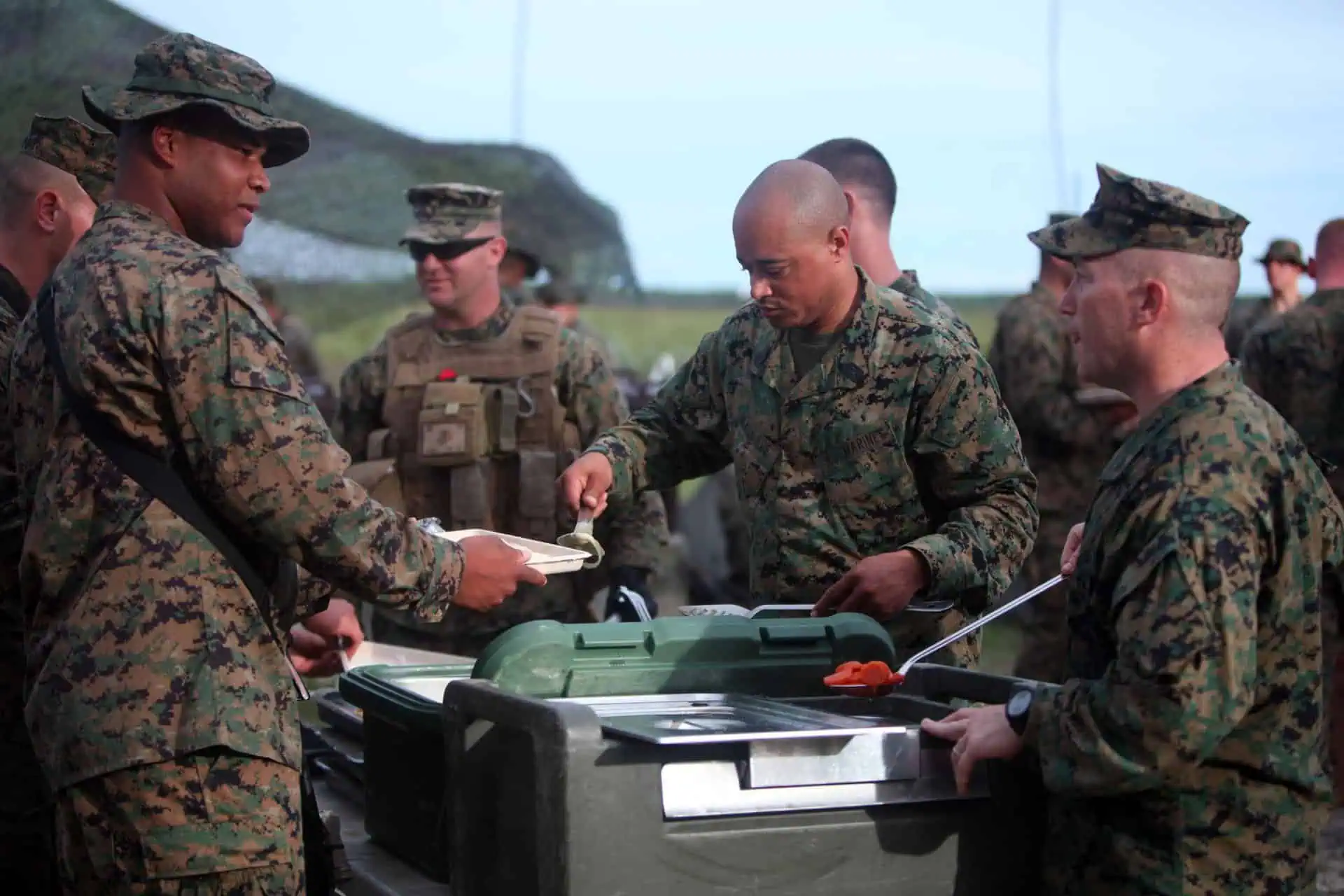Camp Lejeune Bronchus Cancer Lawsuit
- Last Updated: June 12th, 2025

Attorney Jessica Paluch-Hoerman, founder of TruLaw, has over 28 years of experience as a personal injury and mass tort attorney, and previously worked as an international tax attorney at Deloitte. Jessie collaborates with attorneys nationwide — enabling her to share reliable, up-to-date legal information with our readers.
Legally Reviewed
This article has been written and reviewed for legal accuracy and clarity by the team of writers and legal experts at TruLaw and is as accurate as possible. This content should not be taken as legal advice from an attorney. If you would like to learn more about our owner and experienced injury lawyer, Jessie Paluch, you can do so here.
Fact-Checked
TruLaw does everything possible to make sure the information in this article is up to date and accurate. If you need specific legal advice about your case, contact us by using the chat on the bottom of this page. This article should not be taken as advice from an attorney.
Key takeaways:
- The Camp Lejeune Bronchus Cancer Lawsuits have gained national attention due to the exposure of military personnel and their families to contaminated water.
- The toxic substances found in the Camp Lejeune water supply, including TCE, PCE, benzene, and vinyl chloride, have been linked to a 20% higher risk of bronchus cancer among military personnel and civilians stationed there from 1975 to 1985.
- If you or someone you know has developed bronchus cancer or related conditions, contacting TruLaw through the chat on this page can provide a free consultation to determine eligibility for filing a Camp Lejeune Lawsuit.
Overview of the Camp Lejeune Bronchus Cancer Lawsuit
On this page, we’ll discuss an overview of the Camp Lejeune Bronchus Cancer Lawsuit, studies linking bronchus cancer to the contaminated drinking water at Camp Lejeune, who qualifies for the Camp Lejeune Bronchus Cancer Lawsuits, and much more.
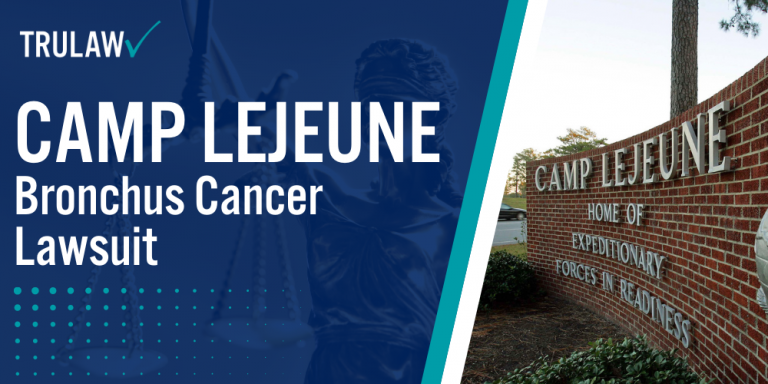
Intro to the Camp Lejeune Bronchus Cancer Lawsuits
The Camp Lejeune Bronchus Cancer Lawsuits have drawn national attention due to the exposure of military personnel and their families to contaminated water.
The toxic substances discovered to have contaminated the Camp Lejeune water supply include volatile organic compounds, such as:
- Trichloroethylene (TCE)
- Perchloroethylene (PCE)
- Benzene, and
- Vinyl chloride
Research conducted by the Agency for Toxic Substances and Disease Registry (ATSDR) in 2024 found that military personnel and civilians stationed at Camp Lejeune from 1975 to 1985 had a 20% higher risk for various cancers, including bronchus cancer, compared to those stationed elsewhere.
If you or someone you love has developed bronchus cancer or any of these conditions, contact TruLaw using the chat on this page to receive a free, no-obligation consultation to see if you qualify to file a Camp Lejeune Lawsuit.
Table of Contents
Link Between Chemical Contaminants in Camp Lejeune's Water Supply and Bronchus Cancer
The bronchus is part of the respiratory system, and cancer in this region is typically classified under the broader category of lung cancer.
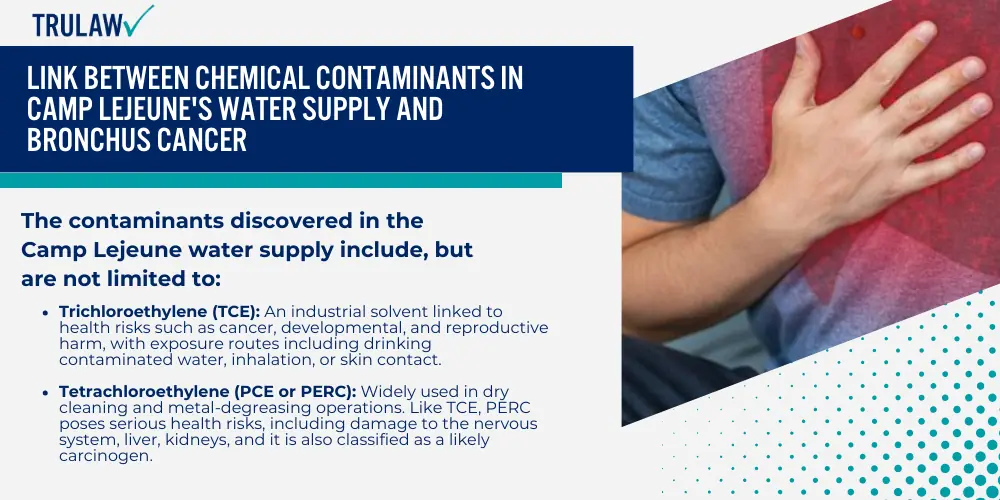
Occupational studies conducted by BMC Public Health reference a significant excess of total cancer deaths among dry-cleaners exposed to solvents like Tetrachloroethylene (PCE).
Given the established link between lung cancer and environmental carcinogens, it is reasonable to infer that an increased risk of lung cancer would encompass bronchus cancer as well.
The contaminants discovered in the Camp Lejeune water supply include, but are not limited to:
- Trichloroethylene (TCE): An industrial solvent linked to health risks such as cancer, developmental, and reproductive harm, with exposure routes including drinking contaminated water, inhalation, or skin contact.
- Tetrachloroethylene (PCE or PERC): Widely used in dry cleaning and metal-degreasing operations. Like TCE, PERC poses serious health risks, including damage to the nervous system, liver, kidneys, and it is also classified as a likely carcinogen.
- Vinyl Chloride (VC): A gas used primarily to make PVC, a type of plastic. Exposure to VC, even at low levels, has been associated with an increased risk of a rare form of liver cancer, as well as damage to the lungs, bronchus, and blood vessels.
- Benzene: A colorless or light yellow liquid used in the manufacture of plastics, resins, synthetic fibers, rubber lubricants, dyes, detergents, drugs, and pesticides. It is known to cause cancer, particularly leukemia, and can affect the bone marrow and blood production.
Contact TruLaw today by using the chat on this page to find out if you qualify to file a Camp Lejeune Bronchus Cancer Lawsuit according to the most recent links discovered between the contaminated water at Camp Lejeune and bronchus cancer.
We offer a free, no-obligation consultation to discuss the details of your case and your potential legal options.
1. Trichloroethylene (TCE)
Trichloroethylene, commonly referred to as TCE, is one of several volatile organic compounds that were found contaminating the water supply at the military base Camp Lejeune and has been a subject of extensive research.
Studies demonstrate that this substance can be carcinogenic when humans are exposed to it over long periods.
The effects of long-term exposure to Trichloroethylene include, but are not limited to:
- Increased risk of certain types of cancer, such as kidney, liver, and non-Hodgkin’s lymphoma.
- Potential damage to the nervous system, which can lead to symptoms like headaches, dizziness, and numbness.
- Respiratory problems, including difficulty breathing and potential harm to lung function.
- Negative impacts on the reproductive system, possibly resulting in infertility or developmental issues in unborn children.
- Liver damage, which may manifest as jaundice or other related health conditions.
It is important for individuals who may have been exposed to TCE to seek medical attention and undergo regular health screenings.
Early detection of any health issues can improve treatment options and outcomes.
2. Tetrachloroethylene (PCE or PERC)
Tetrachloroethylene, also known as PCE or PERC, is another volatile organic compound that shares similarities with TCE in terms of its use and the health risks it poses.
It’s commonly used in dry cleaning and as a degreasing agent in various industries.
Health concerns associated with Tetrachloroethylene include:
- Potential to cause cancer, particularly bladder cancer and non-Hodgkin’s lymphoma.
- Negative effects on the central nervous system, which may result in symptoms such as dizziness, headaches, and coordination issues.
- Liver damage, as evidenced by increased liver enzymes and potential for chronic conditions.
- Respiratory issues, including shortness of breath and irritation of the upper respiratory tract.
- Reproductive risks, including possible links to miscarriage and reproductive system damage.
Like with TCE, it’s crucial for anyone who suspects they’ve been exposed to PCE to get medical advice.
Regular check-ups can catch health problems early, leading to better chances for successful treatment.
Both TCE and PCE are now heavily regulated due to their harmful effects, and efforts are ongoing to clean up contaminated sites and prevent further exposure to these dangerous chemicals.
3. Vinyl Chloride (VC)
Vinyl chloride is a man-made substance primarily used to make polyvinyl chloride (PVC) plastic and vinyl products, which include pipes, wire coatings, and packaging materials.
Exposure to vinyl chloride can occur in the workplace or through the release of the chemical into the environment.
Health risks associated with exposure to vinyl chloride are significant and include:
- A higher chance of developing liver cancer, including a rare form known as hepatic angiosarcoma.
- Damage to the liver that may not be immediately apparent but can progress to liver cirrhosis.
- Neurological effects, such as numbness, tingling of the hands and feet, and difficulty concentrating.
- Respiratory problems, with symptoms like shortness of breath and chest tightness.
- An increased risk of developing Raynaud’s phenomenon, where fingers and toes change color and feel numb in response to cold temperatures or stress.
If you’re concerned about potential exposure to vinyl chloride, it’s essential to seek medical guidance and undergo health screenings.
Protective measures and regulations are in place to limit exposure and protect individuals from the harmful effects of this chemical.
Staying informed about these substances and their impact on health is crucial for prevention and early intervention.
Always use protective equipment when handling chemicals and report any suspected exposure to a healthcare professional promptly.
4. Benzene
Benzene is a well-known industrial chemical found in crude oil and is used in the production of plastics, resins, synthetic fibers, rubber lubricants, dyes, detergents, drugs, and pesticides.
It’s also present in cigarette smoke and can be released by burning coal and oil.
Exposure to benzene can lead to serious health effects, such as:
- An increased risk of developing leukemia, particularly acute myeloid leukemia (AML).
- Bone marrow damage, which can result in a decrease in red blood cells, leading to anemia.
- Immune system suppression, making it harder for the body to fight off infections.
- Potential impact on fertility, with studies suggesting it may affect both male and female reproductive systems.
Due to its toxicity, benzene use is strictly regulated, and safety measures are enforced to protect workers and the general public from exposure.
If you think you’ve been exposed to benzene, it’s important to report this to your healthcare provider and get regular health check-ups to monitor for any potential effects.
Understanding the risks associated with these chemicals is key to preventing their harmful consequences.
Awareness and education can help individuals take the necessary precautions to safeguard their health.
Camp Lejeune Water Contamination Lawsuit: Types of Chemicals
It is now abundantly clear that prolonged exposure to these hazardous chemicals poses a serious risk to human health, magnifying the chances of developing bronchus cancer among other diseases.
As a result, many have taken legal action, pursuing VA disability claims or filing Camp Lejeune bronchus cancer lawsuits in order to seek justice and compensation for the harm endured due to this environmental health catastrophe.
Studies Find Link Between Bronchus Cancer and the Chemicals Found in the Contaminated Drinking Water at Camp Lejeune
The Agency for Toxic Substances and Disease Registry (ATSDR) released a cancer incidence study in 2024 that provided alarming insights into the health impacts of contaminated water at Camp Lejeune.
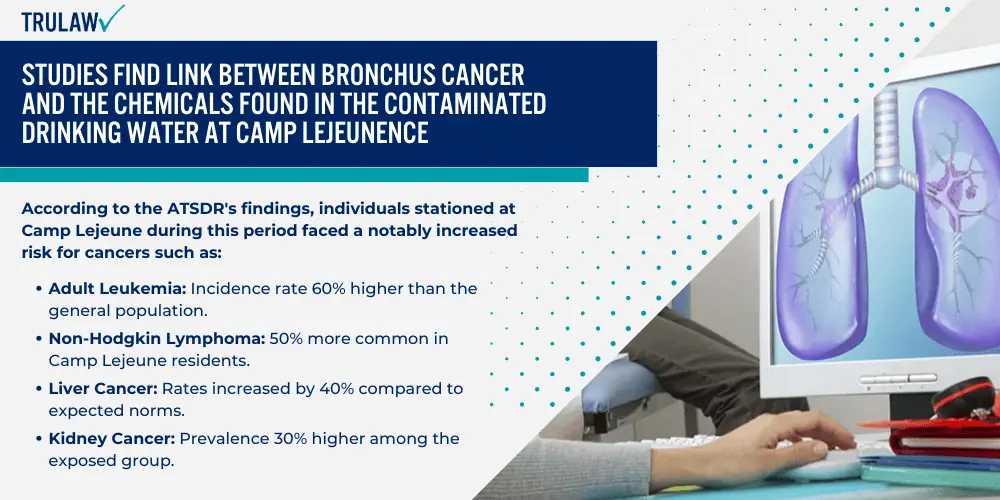
The study specifically notes that military personnel and civilians who were stationed there between 1975 and 1985 had at least a 20% higher risk of developing various forms of cancer compared to those based in non-contaminated environments.
According to the ATSDR’s findings, individuals stationed at Camp Lejeune during this period faced a notably increased risk for cancers such as:
- Adult Leukemia: Incidence rate 60% higher than the general population.
- Non-Hodgkin Lymphoma: 50% more common in Camp Lejeune residents.
- Liver Cancer: Rates increased by 40% compared to expected norms.
- Kidney Cancer: Prevalence 30% higher among the exposed group.
- Bladder Cancer: Risk elevated by 20% for those at Camp Lejeune.
- Breast Cancer: Diagnoses 10% higher than average.
- Bronchus Cancer: Significantly concerning due to its high severity and increased occurrence.
Contact TruLaw today by using the chat on this page to find out if you qualify to file a Camp Lejeune Bronchus Cancer Lawsuit according to the most recent links discovered between the contaminated water at Camp Lejeune and bronchus cancer.
We offer a free, no-obligation consultation to discuss the details of your case and your potential legal options.
Camp Lejeune Bronchus Cancer: VA List, CLJA & Disability Filing
From the 1950s through the end of the 1980s, individuals stationed at, residing in, or employed at Camp Lejeune were exposed to drinking water that was tainted with harmful chemicals.
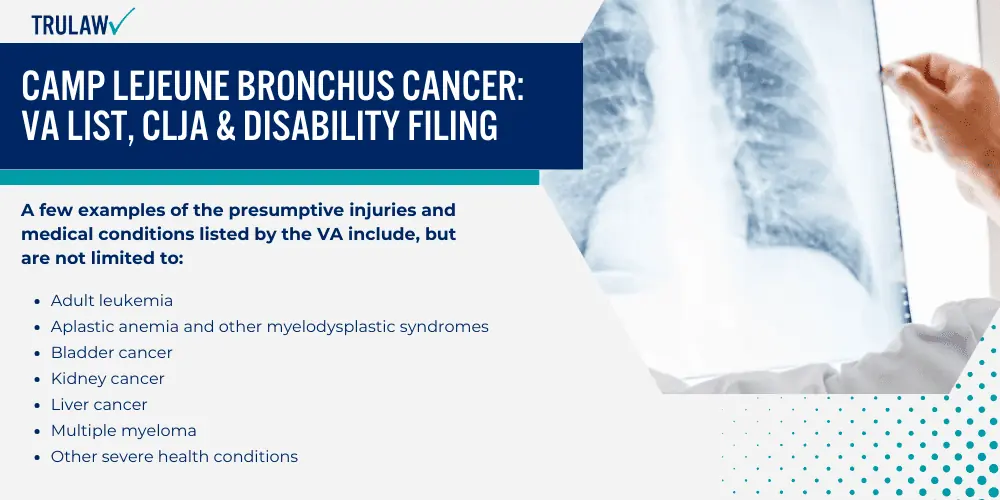
These contaminants have been linked to many adverse health conditions, but one of the most serious is bronchus cancer, a distressing diagnosis that affects numerous veterans and former residents.
Veteran Affairs Presumptive Injury List
The Veterans Affairs (VA) conscientiously maintains a comprehensive list of medical conditions that are presumed to be connected to military service at Camp Lejeune, stemming from its dedication to caring for our nation’s heroes.
A few examples of the presumptive injuries and medical conditions listed by the VA include, but are not limited to:
- Adult leukemia
- Aplastic anemia and other myelodysplastic syndromes
- Bladder cancer
- Kidney cancer
- Liver cancer
- Multiple myeloma
- Non-Hodgkin’s lymphoma
- Parkinson’s disease
Veterans, reservists, and National Guard members who courageously served at least 30 cumulative days at the base between August 1, 1953, and December 31, 1987, may be entitled to benefits if they have developed any of the debilitating conditions on this list.
Camp Lejeune Justice Act of 2022
The Camp Lejeune Justice Act (CLJA), a critical part of the Honoring Our PACT Act of 2022, represents a significant step forward in addressing the injustices faced by those affected by the contaminated water at the base.
Key provisions of the Camp Lejeune Justice Act focus on several important measures including, but not limited to:
- Right to Sue: Affords the right to affected individuals to file a lawsuit against the federal government for harm caused by the contaminated water.
- Statute of Limitations: Establishes a specific time frame within which claims must be filed, ensuring timely pursuit of justice.
- Coverage Period: Defines the period during which individuals must have been exposed to the contaminated water to qualify for making a claim.
- Eligible Claimants: Specifies that veterans, family members, and civilian workers are among those who can seek compensation under the Act.
This pivotal act includes the valiant veterans and their devoted family members, as well as dedicated civilian workers who lived or worked at Camp Lejeune during the time frame specified by the statute.
It provides a necessary avenue for these impacted individuals to file claims to seek the compensation they rightfully deserve.
Filing for Disability Due to Bronchus Cancer
Should you find yourself coping with a bronchus cancer diagnosis and believe it’s directly linked to your time spent at Camp Lejeune, pursuing disability benefits could prove to be a critical lifeline.
Here’s what you need to know about filing for a disability claim in greater detail:
- Eligibility: Your military or employment records must reflect that you served or worked at Camp Lejeune for a minimum of 30 days within the period starting from 1953 to the end of 1987.
- Medical Evidence: Furnish comprehensive medical records including, but not limited to, diagnostic reports, treatment notes, and doctors’ evaluations that conclusively show a bronchus cancer diagnosis.
- Service Connection: Present compelling evidence such as expert opinions or medical literature that supports the assertion that your bronchus cancer is consequent of the contaminated water exposure experience at Camp Lejeune.
- Legal Consultation: seek the guidance of an experienced VA-accredited representative at TruLaw to ensure that we fight for the maximum compensation possible.
Contact TruLaw today by using the chat on this page to find out if you qualify to file a Camp Lejeune Bronchus Cancer Lawsuit according to the most recent links discovered between the contaminated water at Camp Lejeune and bronchus cancer.
We offer a free, no-obligation consultation to discuss the details of your case and your potential legal options.
Tips to File a Camp Lejeune Lawsuit
Filing a Camp Lejeune Water Lawsuit involves a few critical steps, including proving your presence at Camp Lejeune, showing documentation of illness, filing a claim with the VA, and seeking legal representation.
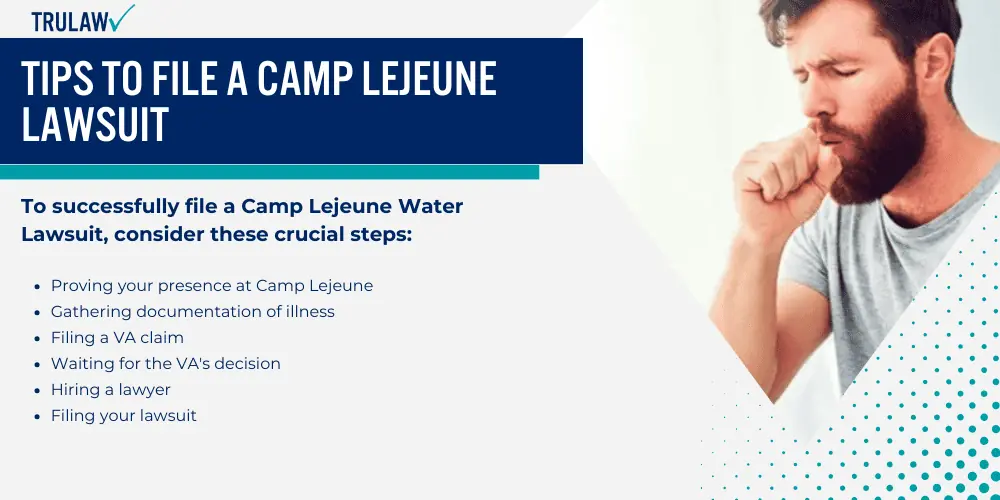
This process requires diligence and careful attention to detail.
To successfully file a Camp Lejeune Water Lawsuit, consider these crucial steps:
- Proving your presence at Camp Lejeune
- Gathering documentation of illness
- Filing a VA claim
- Waiting for the VA’s decision
- Hiring a lawyer
- Filing your lawsuit
By following these steps, you increase your chances of successfully obtaining compensation for your illness due to the water contamination at Camp Lejeune.
Challenges in the Camp Lejeune Bronchus Cancer Lawsuit
The Camp Lejeune Bronchus Cancer Lawsuit presents unresolved litigation issues, such as deciding which cases should proceed to trial and who should make these decisions.
A key point of contention is whether Camp Lejeune claims should be heard by a jury, a position disputed by the U.S. Department of Justice, while plaintiffs argue that the law, known as the PACT Act, permits jury trials.
Here are some potential challenges that legal teams, plaintiffs, and the judicial system as a whole may encounter in the Camp Lejeune Bronchus Cancer Lawsuit:
- Unresolved Litigation Issues: These issues include determining which cases should move forward to trial and who should make those decisions.
- Dispute over Jury Trials: The U.S. Department of Justice argues against jury trials, while plaintiffs believe that the PACT Act, a law directly related to the lawsuit, allows for them.
- Proving Exposure and Causation: It requires substantial scientific evidence and expert testimony, which can be difficult and costly to obtain.
- Complex Medical Evidence: Understanding and presenting complex medical evidence is challenging. It often requires breaking down intricate details into information that a judge or jury can easily grasp.
- Coordination of Numerous Claims: With potentially thousands of claims, coordinating them in a way that is fair and efficient poses a significant logistical challenge.
Each of these challenges are unique, demanding personalized consideration and attention to detail.
The legal process may be challenging, but with determination and the right approach, those harmed by the contamination at Camp Lejeune can hope to find some measure of closure and relief.
Eligibility Criteria for Camp Lejeune Bronchus Cancer Claimants
If you’re looking to file a bronchus cancer claim related to Camp Lejeune, it’s essential to know if you qualify.
Many people who were at the military base during a certain time frame may be eligible for compensation due to health issues caused by contaminated water.
Significant factors that determine the eligibility criteria for Camp Lejeune bronchus cancer claimants include, but are not limited to:
- Time Period on Base: You must have lived or worked at Camp Lejeune during the specified dates when the contamination was known to be at its worst. The authorized time frame usually spans several decades, starting from the early 1950s to the late 1980s.
- Duration of Exposure: To be eligible, individuals must have a minimum cumulative exposure—often totaling at least 30 days. This duration does not need to be consecutive; cumulative exposure counts towards eligibility.
- Medical Diagnosis: Your records must clearly confirm a bronchus cancer diagnosis, linked by scientific evidence to contaminated water at Camp Lejeune.
- Proof of Presence: Substantiating your presence at Camp Lejeune during the critical period is essential. This could include military records, employment documentation, housing records, or any other official documents that place you at the base within the designated time window.
- Time at Camp Lejeune: You must have lived or worked at Camp Lejeune during the time when the water was most polluted. This period is often from the early 1950s to the late 1980s.
Understanding these criteria is the first step in pursuing a claim.
Contact an experienced personal injury attorney at TruLaw using the chat on this page for guidance through the claims process and investigate your options to pursue compensation.
Filing a Camp Lejeune Bronchus Cancer Claim
Filing a bronchus cancer claim due to exposure at Camp Lejeune involves several steps, tailored to meet the criteria set by the government for those affected by the water contamination incident.
Eligibility for such claims is typically based on service duration and diagnosis of specific health conditions.
Here’s a detailed breakdown of the process of filing a claim for bronchus cancer that developed as a result of your time at Camp Lejeune:
- Determine your eligibility: Confirm that you served at Camp Lejeune or MCAS New River for at least 30 days from August 1, 1953, to December 31, 1987, and have been diagnosed with bronchus cancer.
- Gather necessary documentation: Collect all relevant service records showing your time at Camp Lejeune and medical records documenting your bronchus cancer diagnosis.
- File your claim: Submit your claim through the VA’s benefits portal, by mail, in person at a VA office, or with assistance from a VSO or attorney. Ensure accuracy to prevent delays.
- Wait for the VA’s decision: The VA will review your case and issue a decision. If denied, you can appeal with new evidence or arguments.
Each step you take brings you closer to potentially receiving the benefits you deserve.
It’s important to approach this process with diligence and attention to detail.
Camp Lejeune Justice Act 2022: Key Provisions
The Camp Lejeune Justice Act of 2022 (CLJA) provides compensation to individuals affected by contaminated water at Camp Lejeune.
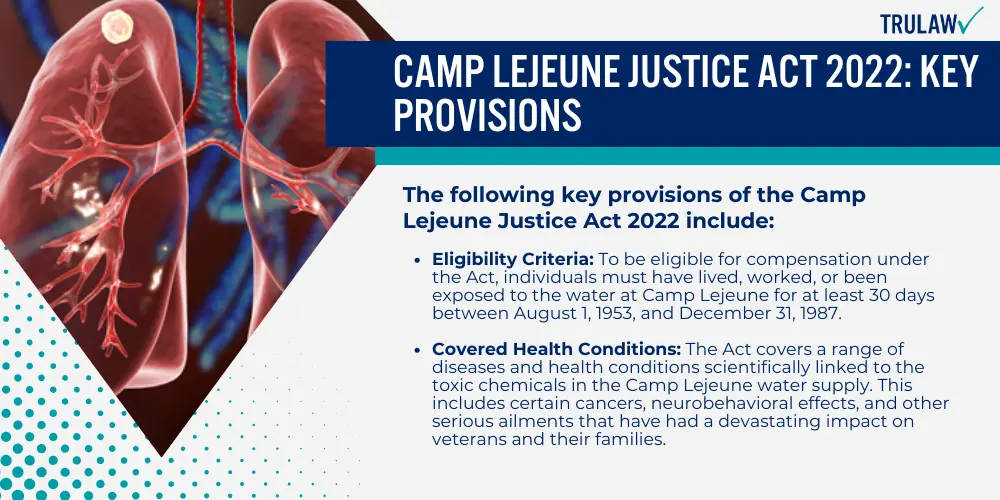
This legislation aims to acknowledge the health issues caused by environmental negligence and extending eligibility to military family members, civilian employees, and visitors who can demonstrate their health issues are related to the toxic exposure.
The following key provisions of the Camp Lejeune Justice Act 2022 include:
- Eligibility Criteria: To be eligible for compensation under the Act, individuals must have lived, worked, or been exposed to the water at Camp Lejeune for at least 30 days between August 1, 1953, and December 31, 1987.
- Covered Health Conditions: The Act covers a range of diseases and health conditions scientifically linked to the toxic chemicals in the Camp Lejeune water supply. This includes certain cancers, neurobehavioral effects, and other serious ailments that have had a devastating impact on veterans and their families.
- Simplified Claims Process: A streamlined claims process has been established, allowing affected individuals to file claims directly against the government for harm caused by the water contamination. This eliminates the need for lengthy litigation and provides easier access to justice and compensation.
- Waiver of Immunity: In an unprecedented move, the U.S. government has waived its traditional immunity for certain claims related to the Camp Lejeune water contamination. This waiver promotes accountability and enables those affected to seek legal recourse.
The Camp Lejeune Justice Act 2022 stands as a testament to a collective commitment to addressing past wrongs and ensuring that those who served their country, along with their families, receive the justice and support they so rightfully deserve.
Through these key provisions, the Act not only offers restitution but also paves the way for a more responsible and responsive approach to the health and wellbeing of service members and associated civilians in the future.
Qualification Criteria For The Camp Lejeune Justice Act
The Camp Lejeune Justice Act of 2022 is designed to provide compensation to those affected by water contamination at Camp Lejeune.
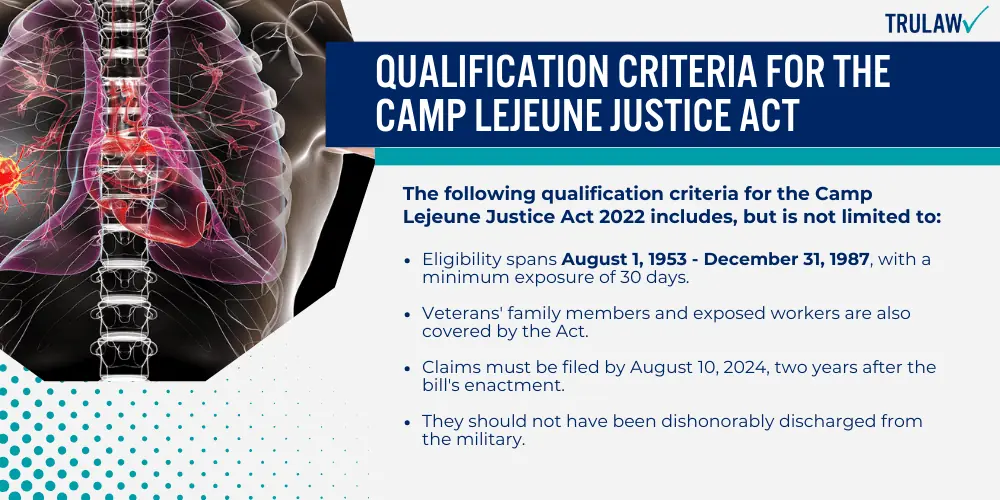
The qualification criteria for the Camp Lejeune Justice Act are based on a few key eligibility requirements.
The following qualification criteria for the Camp Lejeune Justice Act 2022 includes, but is not limited to:
- Eligibility spans August 1, 1953 – December 31, 1987, with a minimum exposure of 30 days.
- Veterans’ family members and exposed workers are also covered by the Act.
- Claims must be filed by August 10, 2024, two years after the bill’s enactment.
- They should not have been dishonorably discharged from the military.
- Residence at the base as a veteran, civilian, employee, or a loved one of a service member.
Contact TruLaw today by using the chat on this page to find out if you qualify to file a Camp Lejeune Bronchus Cancer Lawsuit according to the most recent links discovered between the contaminated water at Camp Lejeune and bronchus cancer.
We offer a free, no-obligation consultation to discuss the details of your case and your potential legal options.
Potential Compensation in the Camp Lejeune Bronchus Cancer Lawsuit
The connection between exposure to harmful substances like trichloroethylene (TCE), perchloroethylene (PCE), vinyl chloride, benzene, and other volatile organic compounds at Camp Lejeune and various health conditions has raised significant concerns.
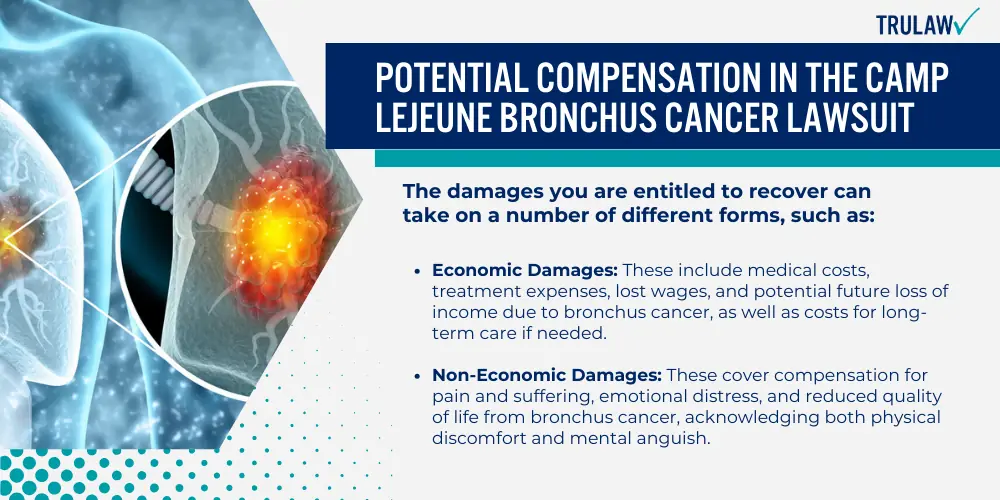
The damages you are entitled to recover can take on a number of different forms, such as:
- Economic Damages: These include medical costs, treatment expenses, lost wages, and potential future loss of income due to bronchus cancer, as well as costs for long-term care if needed.
- Non-Economic Damages: These cover compensation for pain and suffering, emotional distress, and reduced quality of life from bronchus cancer, acknowledging both physical discomfort and mental anguish.
- Punitive Damages: Aimed not at compensation but at punishment, these damages target the responsible parties for contamination at Camp Lejeune when their actions were particularly harmful or reckless, discouraging future negligence.
If you or a loved one has been diagnosed with bronchus cancer and suspect it may be linked to the water contamination at Camp Lejeune, TruLaw is here to provide guidance.
Use the chat feature on this page to start a conversation for a free, no-commitment consultation.
When discussing potential compensation in the Camp Lejeune Bronchus Cancer Lawsuit, it’s important to understand the following key aspects:
1. Economic Damages in the Camp Lejeune Bronchus Cancer Lawsuit
Economic damages refer to the measurable economic losses incurred by the plaintiff as a result of the defendant’s negligence.
In the Camp Lejeune Bronchus Cancer Lawsuit, this could include medical bills, loss of income, and any other out-of-pocket expenses directly related to the illness.
Key points to remember about Economic Damages include:
- They are quantifiable and can include medical costs, loss of income, and other associated expenses.
- The amount is usually calculated based on the actual expenses incurred and projected future expenses.
- Receipts, invoices, wage statements, and other documentation are typically required to substantiate these claims.
2. Non Economic Damages in the Camp Lejeune Bronchus Cancer Lawsuit
Non-economic damages are awarded for the intangible losses suffered by the plaintiff, such as pain and suffering, emotional distress, loss of enjoyment of life, and loss of consortium.
The value of these damages is subjective and varies greatly from case to case.
Here are the important facts about Non-Economic Damages:
- They are not easily quantifiable and can vary greatly from case to case.
- These damages can include compensation for pain and suffering, emotional distress, and loss of enjoyment of life.
- The amount awarded is determined by the jury and can be influenced by the severity of the plaintiff’s suffering and the impact on their quality of life.
3. Punitive Damages in the Camp Lejeune Bronchus Cancer Lawsuit
Punitive damages are awarded to plaintiffs as a form of punishment for the defendant and a deterrent for others to engage in similar conduct.
These damages may be awarded if it can be proven that the military base acted with gross negligence or intentional misconduct.
Here’s what you need to know about Punitive Damages:
- They are not awarded in every case, as they require proof of gross negligence or intentional misconduct.
- The amount of punitive damages is determined by the court and can vary significantly from case to case.
- Punitive damages are meant to punish the defendant and deter similar conduct in the future.
Concluding Camp Lejeune Bronchus Cancer Lawsuit
The Camp Lejeune Bronchus Cancer Lawsuit represents a significant effort to address the challenges faced by individuals diagnosed with this disease.
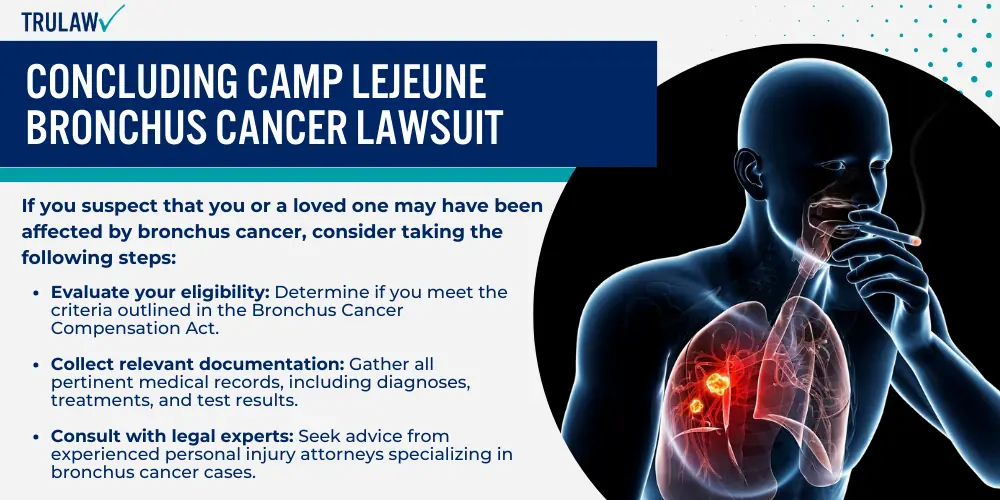
It’s an opportunity for victims to seek compensation and hold responsible parties accountable in the context of ongoing legal proceedings.
If you suspect that you or a loved one may have been affected by bronchus cancer, consider taking the following steps:
- Evaluate your eligibility: Determine if you meet the criteria outlined in the Bronchus Cancer Compensation Act.
- Collect relevant documentation: Gather all pertinent medical records, including diagnoses, treatments, and test results.
- Consult with legal experts: Seek advice from experienced personal injury attorneys specializing in bronchus cancer cases.
- Initiate a claim: Complete and submit the necessary paperwork to commence your lawsuit or compensation claim.
- Prioritize your health: Continue regular medical check-ups and screenings to monitor your condition.
The deadline for filing a claim under the Bronchus Cancer Compensation Act is approaching.
Don’t hesitate to take the first step towards potential compensation through the Bronchus Cancer Lawsuit.
Contact our team today via the chat feature on this page for a complimentary consultation and explore your legal options without any obligation.
We are dedicated to fighting for your rights and seeking justice on your behalf.
Camp Lejeune Water Contamination Lawsuit Frequently Asked Questions
-
What cancers qualify for Camp Lejeune lawsuit?
Eligible cancers for a Camp Lejeune lawsuit include, but are not limited to, bladder, breast, bronchus, esophageal, kidney, and lung cancers, alongside leukemia.
These conditions have been associated with the contaminated water exposure at the base, qualifying affected individuals for legal claims.
-
What is the average payout for Camp Lejeune lawsuit?
The average payout for a Camp Lejeune lawsuit varies, but settlements may range from $10,000 to over $1,000,000.
The specific amount can vary depending on various factors unique to each case.
Therefore, it is advisable to discuss the details of your situation with an experienced Bronchus Cancer Lawyer who specializes in these types of lawsuits.
You can easily connect with a member of our team through the chat feature at the bottom of this page.
In as little as 60 seconds, you can discuss your case and determine if you qualify for a Camp Lejeune Bronchus Cancer Lawsuit.
-
How far back does the Camp Lejeune lawsuit go?
The Camp Lejeune lawsuit allows individuals exposed to toxic water between 1953 and 1987 to seek legal action.
Claimants have a two-year window from the act’s enactment date to file a lawsuit at the US District Court in Eastern North Carolina

Managing Attorney & Owner
With over 25 years of legal experience, Jessica Paluch-Hoerman is an Illinois lawyer, a CPA, and a mother of three. She spent the first decade of her career working as an international tax attorney at Deloitte.
In 2009, Jessie co-founded her own law firm with her husband – which has scaled to over 30 employees since its conception.
In 2016, Jessie founded TruLaw, which allows her to collaborate with attorneys and legal experts across the United States on a daily basis. This hypervaluable network of experts is what enables her to share the most reliable, accurate, and up-to-date legal information with our readers!
Additional Camp Lejeune Water Contamination Lawsuit resources on our website:
Here, at TruLaw, we’re committed to helping victims get the justice they deserve.
Alongside our partner law firms, we have successfully collected over $3 Billion in verdicts and settlements on behalf of injured individuals.
Would you like our help?
At TruLaw, we fiercely combat corporations that endanger individuals’ well-being. If you’ve suffered injuries and believe these well-funded entities should be held accountable, we’re here for you.
With TruLaw, you gain access to successful and seasoned lawyers who maximize your chances of success. Our lawyers invest in you—they do not receive a dime until your lawsuit reaches a successful resolution!
AFFF Lawsuit claims are being filed against manufacturers of aqueous film-forming foam (AFFF), commonly used in firefighting.
Claims allege that companies such as 3M, DuPont, and Tyco Fire Products failed to adequately warn users about the potential dangers of AFFF exposure — including increased risks of various cancers and diseases.
Depo Provera Lawsuit claims are being filed by individuals who allege they developed meningioma (a type of brain tumor) after receiving Depo-Provera birth control injections.
A 2024 study found that women using Depo-Provera for at least 1 year are five times more likely to develop meningioma brain tumors compared to those not using the drug.
Suboxone Tooth Decay Lawsuit claims are being filed against Indivior, the manufacturer of Suboxone, a medication used to treat opioid addiction.
Claims allege that Indivior failed to adequately warn users about the potential dangers of severe tooth decay and dental injuries associated with Suboxone’s sublingual film version.
Social Media Harm Lawsuits are being filed against social media companies for allegedly causing mental health issues in children and teens.
Claims allege that companies like Meta, Google, ByteDance, and Snap designed addictive platforms that led to anxiety, depression, and other mental health issues without adequately warning users or parents.
Transvaginal Mesh Lawsuits are being filed against manufacturers of transvaginal mesh products used to treat pelvic organ prolapse (POP) and stress urinary incontinence (SUI).
Claims allege that companies like Ethicon, C.R. Bard, and Boston Scientific failed to adequately warn about potential dangers — including erosion, pain, and infection.
Bair Hugger Warming Blanket Lawsuits involve claims against 3M — alleging their surgical warming blankets caused severe infections and complications (particularly in hip and knee replacement surgeries).
Plaintiffs claim 3M failed to warn about potential risks — despite knowing about increased risk of deep joint infections since 2011.
Baby Formula NEC Lawsuit claims are being filed against manufacturers of cow’s milk-based baby formula products.
Claims allege that companies like Abbott Laboratories (Similac) and Mead Johnson & Company (Enfamil) failed to warn about the increased risk of necrotizing enterocolitis (NEC) in premature infants.
Here, at TruLaw, we’re committed to helping victims get the justice they deserve.
Alongside our partner law firms, we have successfully collected over $3 Billion in verdicts and settlements on behalf of injured individuals.
Would you like our help?
